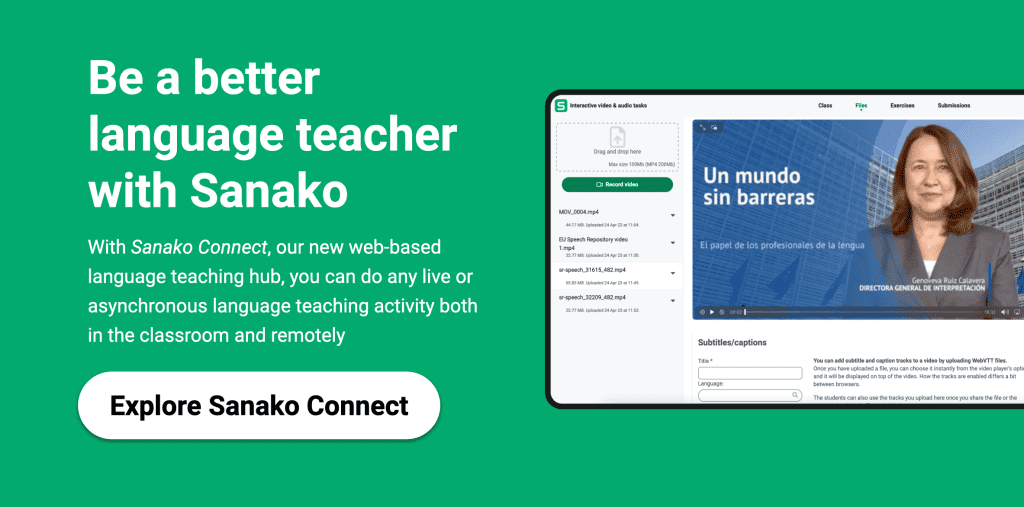In today’s dynamic world where effective communication and collaboration are essential skills, language educators are looking for more engaging and practical approaches to building their students’ core language skills. As we’ve previously written, project-based learning (PBL) is an increasingly popular way to bring language learning to life.
For many educators, PBL is a group learning exercise where students work together to achieve a common objective. In such cases, the success of the approach largely depends on students working collaboratively in order to strengthen their language proficiency but also to develop crucial skills for their future language learning and intercultural competence.
This blog post therefore explores 8 practical strategies to address this challenge. We’ve identified key tips, specifically tailored for language teachers, to develop and nurture student collaboration in group project-based learning environments.
(For a detailed overview of PBL and how to deploy it in your classroom, please refer to our earlier blog post on the topic “How Sanako Connect supports educators to deliver Project-Based Learning”)
Why project-based learning?
Project-based learning is a highly effective approach to improving students’ language skills. Engaging them in real-world tasks and collaborative projects provides learners with meaningful and practical opportunities to apply their knowledge. This not only enhances language proficiency but also fosters key life skills such as critical thinking, problem-solving, and creativity.
As outlined above, PBL activities also promote collaboration and teamwork among students. Language learning becomes a social and interactive experience as students work together to plan, research, and present their projects. Through collaboration, students can learn from their peers, exchange ideas and provide constructive feedback to one another.
Strategies for successful project-based learning
But how can language educators best encourage and foster that collaboration in their classrooms? We’ve reviewed classroom best practice, literature and research to identify the following 8 strategies for you to deploy now.
1. Cultivate a collaborative language learning environment
It all starts by creating a classroom culture that values collaboration and encourages students to actively engage in their language production. Educators should emphasise the importance of teamwork, respect for different views and teach effective communication strategies (see below). The classroom should be an inclusive space where students are comfortable taking risks, sharing their ideas and working with their peers.
2. Define roles and responsibilities
It is important that all students are assigned roles and responsibilities within their teams to ensure that everyone contributes to the project. Such roles could relate to specific elements of language (e.g vocabulary researcher or grammar expert) or to the general running of the team (e.g. project manager or designer). In any case, students should rotate these roles regularly to allow everyone to develop a wide range of skills and to experience different aspects of collaboration.
3. Teach communication strategies
Good communication skills are an essential support for effective collaboration. Educators should provide guidance on active listening, how to ask clarifying questions and how to best facilitate group discussions. One of the best ways to do this is to provide opportunities for students to practise within their teams.
4. Scaffold and support
Developing these skills will not happen immediately for all learners. Some students may require scaffolding to build their collaboration skills, so provide structured opportunities for collaboration. Maybe you could begin with smaller language-focused tasks or pair activities and progressively move towards more complex projects? It’s also important to provide guidance on how to divide language production tasks, establishing timelines and setting goals as a team.
5. Foster peer-to-peer feedback
When working in a team, it’s vital that students are encouraged to provide language feedback to their teammates. Help them to learn how to give constructive feedback on vocabulary usage or grammar accuracy. Frameworks and rubrics can be useful to guide their language evaluations and provide a useful structure to follow. (See our dedicated blog post on this topic here “Peer-to-peer feedback – unlock the hidden power of your students“.).
6. Promote reflection and evaluation
Students need time to reflect individually, and as a group, on their project and on the language they have learnt whilst doing it. Encourage them to discuss challenges encountered, language skills developed and to identify where they could improve. Equally, don’t forget to showcase outstanding language learning outcomes and provide opportunities for students to present their projects in the target language within the classroom and beyond.
7. Keep it real
One of the key benefits of PBL is its ability to make language learning more authentic and relevant. Students quickly become immersed in projects that interest and engage them. This also helps foster collaboration as they work together in a purposeful way to, for example, create a video documentary about a cultural topic or to debate a current issue.
8. Leverage educational technology
There’s a wide variety of technology tools that facilitate / support PBL delivery and which encourage collaboration such as Sanako Connect. Connect makes it really easy for teachers / students to share a wide variety of learning material (e.g. PDFs, presentations, videos, web pages, or even 3rd party applications) and to provide feedback to the ongoing online project plan.
How effective is PBL in language teaching?
There’s an increasing body of research evidence that demonstrates how authentic, student-driven approaches to project-based learning can improve student outcomes. That research applies across different student age groups and across different subjects.
Research conducted by Dua’ Ghosheh Wahbeh et al (“The Role of Project-Based Language Learning in Developing Students’ Life Skills“) specifically identified that project-based language learning enhanced students’ communication skills in the target language. It found that learners engaged in more meaningful interactions, expressed their ideas and practised effective listening and speaking skills. This all led to improved oral and written communication abilities.
Their research also evidenced a highly positive impact on the development of students’ life skills. It found that project-based learning encouraged students to think critically and solve problems independently; that students were encouraged to explore creative solutions and innovative approaches; it equipped students with problem-solving skills and provided opportunities for students to take on leadership roles within their teams. Overall, it helped prepare students for success in both academic and real-world contexts.
For language teachers, fostering student collaboration during project-based learning activities is an essential way to encourage meaningful language acquisition and intercultural competence. We hope that the strategies outlined above will help educators to more effectively cultivate a collaborative language learning environment that nurtures teamwork and prepares students for later life. It’s important to recognise that embracing collaboration not only enhances language proficiency but also cultivates lifelong skills that will empower students in their language learning journeys.
Whatever language you teach and wherever you deliver your language lessons, Sanako’s market-leading tools are here to help. We’re constantly innovating and looking to use technology to enable language educators to teach languages more efficiently and more successfully. It’s why the world’s leading educational institutions choose Sanako as their preferred supplier to support online and in-person lesson delivery.
If you are interested in learning more about how Sanako products support language teachers and students and would like to see how they could benefit your institution, click here or the banner below to learn more!

